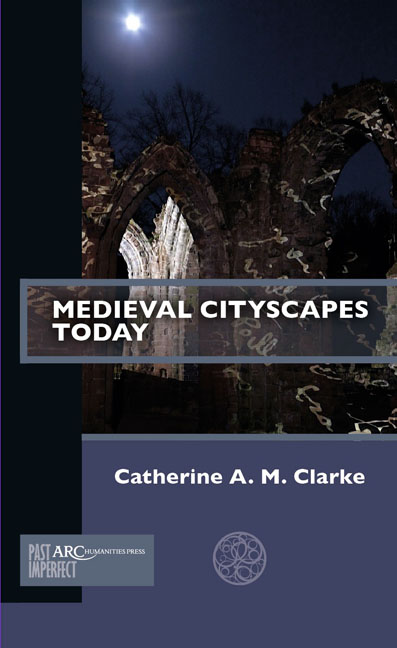Chapter 2 - Swansea: Seeing the Invisible City–Spatial Encounters Past and Present
Published online by Cambridge University Press: 20 November 2020
Summary
This chapter asks questions about how we might begin to recover and interpret lost or absent medieval cityscapes, and models possible approaches through the digital and material strategies which formed elements of the “City Witness” research project in Swansea.
Dylan Thomas Comes Home
In his short radio play Return Journey, commissioned by the BBC and broadcast in 1947, poet Dylan Thomas describes a visit to his childhood home of Swansea, just a few years after the devastation of wartime air raids on the town. Thomas evokes the bombed landscape of Swansea on a cold February day: its “vanished buildings,” the “blitzed flat graves of shops,” and the “havoc’d” town centre. He walks along High Street:
[…] past the flat white wastes where all the shops had been. Eddershaw Furnishers, Curry's Bicycles, Donegal Clothing Company, Doctor Scholl’s, Burton Tailors, W.H. Smith, Boots Cash Chemists, Leslie's Stores, Upson's Shoes, Prince of Wales, Tucker's Fish, Stead & Simpson—all the shops bombed and vanished. Past the hole in space where Hodges & Clothiers had been, down Castle Street, past the remembered, invisible shops […] (pp. 105–6)
Thomas's careful catalogue of absence continues; his faithful recitation of the names of lost, disappeared shops and landmarks forming a solemn reckoning of the town's destruction. Later, recounting his walk along College Street, Thomas uses the same phrase, once more listing the “remembered invisible shops” which he can still imagine in the midst of the ruined urban landscape (p. 111). The “ugly, lovely” pre-war town, described so tenderly in Thomas's Reminiscences of Childhood, has vanished, its buildings “melted” into nothing (p. 114). Yet Thomas still sees each of these familiar landmarks in his mind's eye: he assembles their names into their former rows and sequences along streets; into the remembered narratives of itineraries through the vanished town centre. For Thomas, the Swansea of his childhood is still visible, and present, even amongst the “snow and ruin” of the blitzed streets (p. 108).
Dylan Thomas's personal account of this catastrophic rupture in the landscape and history of Swansea presents another way into thinking about medieval cityscapes today, and especially the challenges and opportunities involved in engaging with lost or “invisible” historic environments.
- Type
- Chapter
- Information
- Medieval Cityscapes Today , pp. 57 - 94Publisher: Amsterdam University PressPrint publication year: 2019



